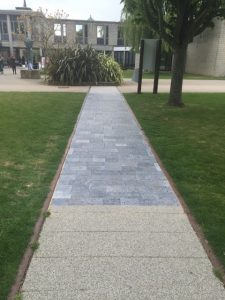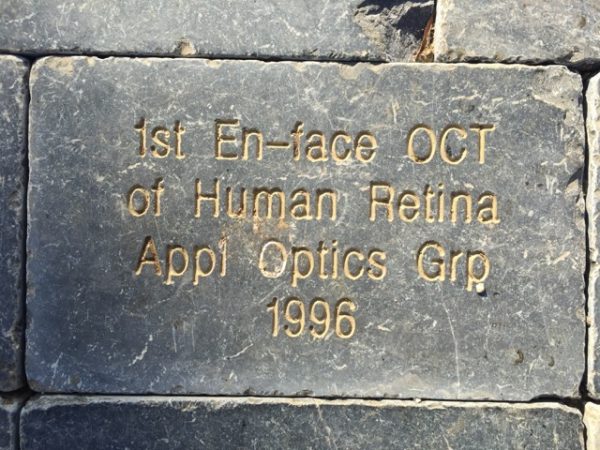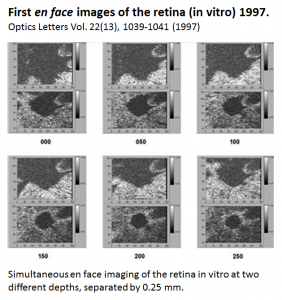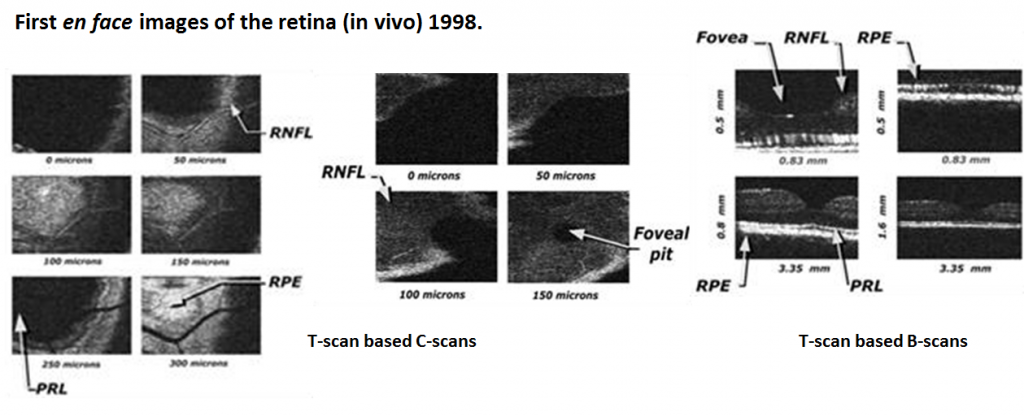Researchers in the Applied Optics Group were the first to demonstrate en-face optical coherence tomography (OCT) images from the retina, now known as C-scans. To mark the event, a special brick has been engraved in the Footstep project (part of the new Crab & Winkle Path alongside the Templeman Library on the campus).


The en face images were made possible by realising that scattering in combination with a fixed coherence gating can generate a C-scan. There is no need for an external phase modulator if the object to be imaged is scattering and the image size is sufficiently large. The modulation is, interestingly, created by scanning the beam over the target.
First, we showed that a Newton ring pattern is sampled from the target:
-
- A. Gh.Podoleanu, G. M. Dobre, D. J. Webb, D. A. Jackson, Imaging by Use of a Newton Rings Sampling Function” Coherence, Republished in “Selected Papers on Optical Low-Coherence Reflectometry & Tomography, B. R. Masters and B. J. Thompson eds., SPIE Milestone Series, vol. MS165, SPIE Optical Engineering Press, Washington, 2000, USA, pp. 200-202. Opt. Lett., Vol. 21, pp. 1789-1791, (1996).

Then we moved the centre of the Newton rings out from the image centre and sampled the target with a grid of lines:
- A. Gh.Podoleanu, G. M. Dobre, D. A. Jackson, En-face Coherence Imaging Using Galvanometer Scanner Modulation, Opt. Letters, (1998), vol. 23, pp. 147-149.
Other key papers include:
- A.Gh.Podoleanu, J. A. Rogers, D. A. Jackson, OCT En-face Images from the Retina with Adjustable Depth Resolution in Real Time, IEEE Journal of Selected Topics in Quantum Electron., 1999, Vol.5, No.4, 1176-1184.
- A. Gh.Podoleanu, G. M. Dobre, M. Seeger, D. J. Webb, D. A. Jackson, F.W. Fitzke, A.S. Halfyard, Low Coherence Interferometry for En-face Imaging of the Retina, Lasers and light in ophthalmology, Vol. 8, No. 3, (1998), pp. 188-192.
- A. Gh.Podoleanu, G. M. Dobre, D. A. Jackson, En-face Coherence Imaging Using Galvanometer Scanner Modulation, Opt. Letters, (1998), vol. 23, pp. 147-149.
- A. Gh.Podoleanu, M. Seeger, G. M. Dobre, D. J. Webb, D. A. Jackson, F. Fitzke
Transversal and Longitudinal Images from the Retina of the Living Eye Using Low Coherence Reflectometry, Journal of Biomedical Optics, 3, (1), (1998),pp. 12-20.
[Republished in “Selected Papers on Optical Low-Coherence Reflectometry & Tomography”, B. R. Masters and B. J. Thompson eds., SPIE Milestone Series, vol.MS165, SPIE Optical Engineering Press, Washington, 2000, USA, pp. 461-469.]

